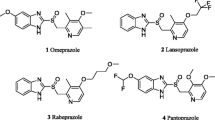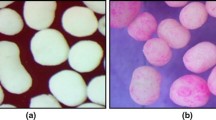Abstract
The effects of filler used in the pellet cores (ie, waxy cornstarch or lactose) and the enteric film coat thickness on the diffusion and dissolution of a freely soluble drug were studied. Two kinds of pellet cores containing riboflavin sodium phosphate as a model drug, microcrystalline cellulose (MCC) as a basic filler, and waxy cornstarch or lactose as a cofiller were film coated (theoretically weight increase 20% or 30%) with an aqueous dispersion of cellulose acetate phthalate (CAP). The diffusion of riboflavin sodium phosphate in aqueous enteric-coated pellets was investigated using noninvasive confocal laser scanning microscopy (CLSM). The in vitro release tests were performed using a USP apparatus I (basket method). Diffusion of drug from the core to the film coat was found to be greater with lactose-containing pellets than with waxy cornstarch-containing pellets. The dissolution test showed that 30% enteric-coated waxy cornstarch pellets had a good acidic resistance in 0.1 N HCl solution for at least 1 hour, while the other enteric pellet formulations failed the test. The waxy cornstarch-containing enteric pellets dissolved at SIF in less than 10 minutes. Confocal images of film-coated pellets showed that waxy cornstarch-containing pellets had less drug dissolved than respective lactose-containing pellets. The observations were further confirmed by measurement of fluorescence intensity of riboflavin sodium phosphate in the film coat. The dissolution test was consistent with the confocal microscopy results. In conclusion, waxy cornstarch as a cofiller in the pellet cores minimizes premature drug diffusion from the core into the film coat layer.
Similar content being viewed by others
References
Chang RK. A comparison of rheological and enteric properties among organic solutions, ammonium salt aqueous solutions, and latex systems of some enteric polymers. Pharm Technol. 1990;10:62–70.
Heinämäki JT, Colarte AI, Nordström AJ, Yliruusi JK. Comparative evaluation of ammoniated aqueous and organic-solvent-based cellulose ester enteric coating systems: a study on free films. Int J Pharm. 1994;109:9–16.
Bianchini R, Resciniti M, Vecchio C. Technology evaluation of aqueous enteric coating systems with and without insoluble additives. Drug Dev Ind Pharm. 1991;17:1779–1794.
Plaizier-Vercammen J, Suenens G. Evaluation of aquateric, a pseudolatex of cellulose acetate phthalate, for its enteric coating properties on tablets. S T P Pharm Sci. 1991;1:307–312.
Dansereau R, Brock M, Redman-Furey N. Solubilization of drug and excipient into a hydroxypropyl methylcellulose (HPMC)-based film coating as a function for the coating parameters in a 24″ accela-cota. Drug Dev Ind Pharm. 1993;19:793–808.
Yang ST, Ghebre-Sellassie I. The effect of product bed temperature on the microstructure of Aquacoatbased controlled-release coatings. Int J Pharm. 1990;60:109–124.
Okhamafe AO, York P. Thermal characterization of drug/polymer and excipient/polymer interactions in some film coating formulation. J Pharm Pharmacol. 1989;41:1–6.
Nagai T. Aqueous Polymeric Coatings for Pharmaceutical Dosage Forms. New York, NY: Dekker; 1997.
Cutts LS, Hibberd S, Adler J, davies MC, Melia CD. Characterising drug release processes within controlled release dosage forms using the confocal laser scanning microscope. J Control Release. 1996;42:115–124.
Guo HX, Heinämäki J, and Yliruusi J. Characterization of particle deformation during compression measured by confocal laser scanning microscopy. Int J Pharm. 1999;186:99–108.
Adler J, Jayan A, Melia CD. A method for quantifying differential expansion within hydrating hydrophilic matrixes by tracking embedded fluorescent microspheres. J Pharm Sci. 1999;88:371–377.
Lamprecht A, Schäfer UF, Lehr CM. Characterization of microcapsules by confocal laser scanning microscopy: structure, capsule wall composition and encapsulation rate. Eur J Pharm Biopharm. 2000;49:1–9.
Junnila R, Palviainen P, Heinämäki J, Myllärinen P, Forssell P, Yliruusi J. Waxy corn starch_a potent cofiller in pellets produced by extrusion-spheronization. Pharm Dev Technol. 2000;5:67–76.
Ragnarsson G, Johansson MO. Coated drug cores in multiple unit preparations: influence of particle size. Drug Dev Ind Pharm. 1988;14:2285–2297.
Ragnarsson G, Sandberg A, Johansson MO, Lindstedt B, Sjögren J. In vitro release characteristics of a membrane-coated pellet formulation: influence of drug solubility and particle size. Int J Pharm. 1992;79:223–232.
Author information
Authors and Affiliations
Corresponding author
Rights and permissions
About this article
Cite this article
Guo, H., Heinämäki, J. & Yliruusi, J. Diffusion of a freely water-soluble drug in aqueous enteric-coated pellets. AAPS PharmSciTech 3, 16 (2002). https://doi.org/10.1208/pt030216
Received:
Accepted:
DOI: https://doi.org/10.1208/pt030216




